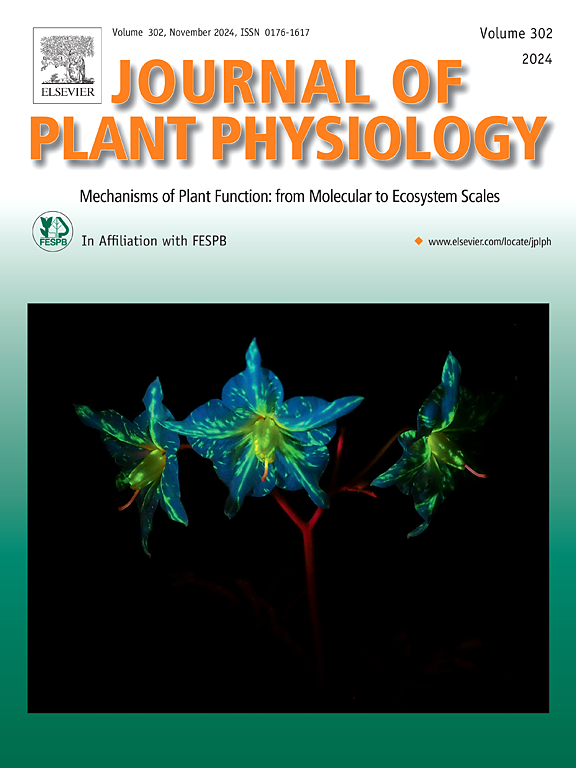Hydrogen sulfide alleviates cadmium stress in germinating carrot seeds by promoting the accumulation of proline
IF 4
3区 生物学
Q1 PLANT SCIENCES
引用次数: 0
Abstract
Carrot (Daucus carota L.), a widely cultivated economically vegetable from the Apiaceae family, is grown globally. However, carrots can be adversely impacted by cadmium (Cd) pollution in the soil due to its propensity to accumulate in the fleshy root, thus impeding carrot growth and posing health hazards to consumers. Given the potential of hydrogen sulfide (H2S) to improve plant resistance against Cd stress, we treated germinating carrot seeds with varying concentrations of sodium hydrosulfide (NaHS), aiming to alleviate the toxic impacts of Cd stress on carrot seed germination. The results revealed that carrot seeds treated with a concentration of 0.25 mM NaHS displayed better seed germination-associated characteristics compared to seeds treated with NaHS concentrations of 0.1 mM and 0.5 mM. Further investigation revealed a rise in the expression levels of L-cysteine desulfhydrase and D-cysteine desulfhydrase, along with enhanced activity of L-cysteine desulfhydrase and D-cysteine desulfhydrase among the NaHS treatment group, thereby leading to H2S accumulation. Moreover, NaHS treatment triggered the expression of pyrroline-5-carboxylate synthase and pyrroline-5-carboxylate reductase and promoted the accumulation of endogenous proline, while the contents of soluble sugar and soluble protein increased correspondingly. Interestingly, since the application of exogenous proline did not influence the accumulation of endogenous H2S, suggesting that H2S served as the upstream regulator of proline. Histochemical staining and biochemical indices revealed that NaHS treatment led to elevated antioxidant enzyme activity, alongside a suppression of superoxide anion and hydrogen peroxide generation. Furthermore, high performance liquid chromatography analysis revealed that NaHS treatment reduced Cd2+ uptake, thereby promoting germination rate, seed vitality, and hypocotyl length of carrot seeds under Cd stress. Overall, our findings shed light on the application of NaHS to enhance carrot resistance against Cd stress and lay a foundation for exploring the regulatory role of H2S in plants responding to Cd stress.
硫化氢通过促进脯氨酸的积累缓解胡萝卜种子萌发过程中的镉胁迫
胡萝卜(Daucus carota L.)是一种广泛栽培的经济型蔬菜,属于伞形科植物,在全球各地均有种植。然而,胡萝卜会受到土壤镉(Cd)污染的不利影响,因为镉(Cd)容易在肉质根中积累,从而阻碍胡萝卜的生长,并对消费者的健康造成危害。鉴于硫化氢(H2S)可提高植物对镉胁迫的抗性,我们用不同浓度的硫氢化钠(NaHS)处理发芽的胡萝卜种子,旨在减轻镉胁迫对胡萝卜种子萌发的毒性影响。结果表明,与 0.1 mM 和 0.5 mM 浓度的 NaHS 处理的种子相比,0.25 mM NaHS 处理的胡萝卜种子显示出更好的种子萌发相关特性。进一步研究发现,在 NaHS 处理组中,L-半胱氨酸脱硫水解酶和 D-半胱氨酸脱硫水解酶的表达水平上升,L-半胱氨酸脱硫水解酶和 D-半胱氨酸脱硫水解酶的活性增强,从而导致 H2S 积累。此外,NaHS 处理引发了吡咯啉-5-羧酸合成酶和吡咯啉-5-羧酸还原酶的表达,促进了内源脯氨酸的积累,同时可溶性糖和可溶性蛋白的含量也相应增加。有趣的是,外源脯氨酸的应用并不影响内源 H2S 的积累,这表明 H2S 是脯氨酸的上游调节因子。组织化学染色和生化指标显示,NaHS 处理可提高抗氧化酶的活性,同时抑制超氧阴离子和过氧化氢的生成。此外,高效液相色谱分析显示,NaHS处理降低了Cd2+的吸收,从而提高了Cd胁迫下胡萝卜种子的发芽率、种子活力和下胚轴长度。总之,我们的研究结果阐明了如何应用 NaHS 增强胡萝卜对镉胁迫的抗性,并为探索 H2S 在植物应对镉胁迫中的调控作用奠定了基础。
本文章由计算机程序翻译,如有差异,请以英文原文为准。
求助全文
约1分钟内获得全文
求助全文
来源期刊

Journal of plant physiology
生物-植物科学
CiteScore
7.20
自引率
4.70%
发文量
196
审稿时长
32 days
期刊介绍:
The Journal of Plant Physiology is a broad-spectrum journal that welcomes high-quality submissions in all major areas of plant physiology, including plant biochemistry, functional biotechnology, computational and synthetic plant biology, growth and development, photosynthesis and respiration, transport and translocation, plant-microbe interactions, biotic and abiotic stress. Studies are welcome at all levels of integration ranging from molecules and cells to organisms and their environments and are expected to use state-of-the-art methodologies. Pure gene expression studies are not within the focus of our journal. To be considered for publication, papers must significantly contribute to the mechanistic understanding of physiological processes, and not be merely descriptive, or confirmatory of previous results. We encourage the submission of papers that explore the physiology of non-model as well as accepted model species and those that bridge basic and applied research. For instance, studies on agricultural plants that show new physiological mechanisms to improve agricultural efficiency are welcome. Studies performed under uncontrolled situations (e.g. field conditions) not providing mechanistic insight will not be considered for publication.
The Journal of Plant Physiology publishes several types of articles: Original Research Articles, Reviews, Perspectives Articles, and Short Communications. Reviews and Perspectives will be solicited by the Editors; unsolicited reviews are also welcome but only from authors with a strong track record in the field of the review. Original research papers comprise the majority of published contributions.
文献相关原料
公司名称
产品信息
阿拉丁
D-Cysteine
阿拉丁
L-Cysteine
阿拉丁
NaHS
 求助内容:
求助内容: 应助结果提醒方式:
应助结果提醒方式:


